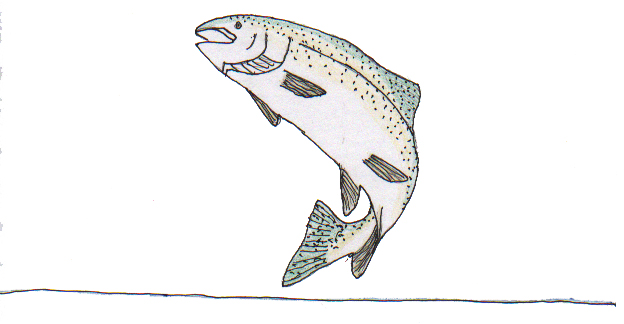 Marshall
Cultural Atlas Marshall
Cultural Atlas
This collection of student work is from
Frank Keim's classes. He has wanted to share these works for others
to use as an example of Culturally-based curriculum and documentation. These
documents have been OCR-scanned. These are available
for educational use only.
Rainbow Trout
(Salmo gairdneri)
(Talaariq)
The Rainbow trout is special among American game
fishes. They were first discovered in the early 1900's. The Rainbow
trout has demonstrated an unusual ability to adapt to a wide range of
living conditions and has been cultured more widely and successfully
in hatcheries than any other trout.
Sea-going rainbows, known as steelhead, are the
Pacific Ocean counterpart of their close relative, the Atlantic
salmon. There is no physical difference between the steelhead and the
rainbow trout except that the steelhead spends part of its life in
saltwater.
Rainbow trout have a streamlined salmonid form,
though body shape and coloration vary widely and reflect habitat,
age, sex and degree of maturity. The back is usually a greenish color
and the lateral line is usually pink. Below the lateral line it is
silver colored, and on the bottom it is pure white.They have black
spots on the upper part and on the upper fins and tail.
In Alaska Rainbow trout are now flourishing and
they have been introduced in many lakes in Southeastern,
Southcentral, and Interior Alaska.
During the late winter and early spring when the
temperatures are starting to rise they look for a place to spawn, and
some even spawn three times.
The female makes the nest or redd and she may lay
200 to 8000 eggs, depending on her size. The nest protects the buried
eggs during the period of incubation. The eggs may take a couple of
weeks to four months to hatch, depending on the water
temperature.
Alaska has the world's record steelhead, taken
near Ketchikan in 1970. It weighed 42 pounds, 2 ounces.
By Willie Paul
Fitka

Christmastime Tales
Stories real and imaginary about Christmas, Slavik, and the New Year
Winter, 1996 |
Christmastime Tales II
Stories about Christmas, Slavik, and the New Year
Winter, 1998 |
Christmastime Tales III
Stories about Christmas, Slavik, and the New Year
Winter, 2000 |
| Summer Time Tails 1992 |
Summertime Tails II 1993 |
Summertime Tails III |
| Summertime Tails IV Fall, 1995 |
Summertime Tails V Fall, 1996 |
Summertime Tails VI Fall, 1997 |
| Summertime Tails VII Fall, 1999 |
Signs of the Times November 1996 |
Creative Stories From Creative Imaginations |
| Mustang Mind Manglers - Stories of the Far Out,
the Frightening and the Fantastic 1993 |
Yupik Gourmet - A Book of
Recipes |
|
| M&M Monthly |
|
|
| Happy Moose Hunting! September Edition 1997 |
Happy Easter! March/April 1998 |
Merry Christmas December Edition 1997 |
| Happy Valentine’s
Day! February Edition
1998 |
Happy Easter! March/April Edition 2000 |
Happy Thanksgiving Nov. Edition, 1997 |
| Happy Halloween October 1997 Edition |
Edible and Useful Plants of Scammon
Bay |
Edible Plants of Hooper Bay 1981 |
| The Flowers of Scammon Bay Alaska |
Poems of Hooper Bay |
Scammon Bay (Upward Bound Students) |
| Family Trees and the Buzzy Lord |
It takes a Village - A guide for parents May 1997 |
People in Our Community |
| Buildings and Personalities of
Marshall |
Marshall Village PROFILE |
Qigeckalleq Pellullermeng ‘A
Glimpse of the Past’ |
| Raven’s
Stories Spring 1995 |
Bird Stories from Scammon Bay |
The Sea Around Us |
| Ellamyua - The Great Weather - Stories about the
Weather Spring 1996 |
Moose Fire - Stories and Poems about Moose November,
1998 |
Bears Bees and Bald Eagles Winter 1992-1993 |
| Fish Fire and Water - Stories about fish, global warming
and the future November, 1997 |
Wolf Fire - Stories and Poems about Wolves |
Bear Fire - Stories and Poems about Bears Spring,
1992 |
|